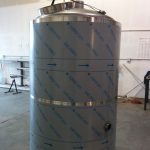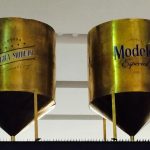What gets people to support local craft beer (“the craft beer revolution”)?
Seattle: land of localvores, hops, opportunity, and… hopportunity?
It’s a rainy afternoon and I’m sitting at one of my favorite beer establishments, sipping something that used to be a pumpkin stout. (Note: it’s March.) The owner sour-aged this beer in a barrel for 4+ months, directly on the bar. He grinned as he poured samples for clamoring patrons. I didn’t bother sampling, opting instead for a full 10oz. pour. (Note: it’s strong.) I’m convinced I do my best beer writing while imbibing the best beer. So in the name of journalism and science, I polled customers and blended their insight with my own. I then barrel aged these thoughts and filtered the results through several pints.
Art + science + craft beer = fun for (brain + liver)
To say I’m sitting among craft beer fans right now is an understatement. It’s a weeknight- still light outside, and the crowd’s growing as patrons navigate the revolving beer list, training up on new offerings. As a homebrew friend told me, “we don’t go out drinking; we go researching.” Make no mistake; we reside within a stronghold of the craft beer revolution. The revolution metaphor’s well suited; this city has scholars, visionaries, foot soldiers, and support from the local townships- just like a real uprising. We dry hop on the shoulders of giants who have brewed before us. It’s as if there’s a mission statement- an unspoken declaration in cities throughout the PNW: A revolution is brewing. We have the right ingredients. It is time.
As overheard, “so we’re geeks who obsess about consuming locally produced quality beverage. Is that it?”
“Well, that, and we’re seasonally depressed.”
“Yeah... makes sense.”
So there’s your overarching answer, Seattle. As it turns out, there’s a beer style for each cycle of seasonal depression. Coffee stout anyone?
 To
To quip quaff
So what specifically inspires this movement and keeps areas like Seattle leading the charge? I polled several patrons and servers to get their take. Here are some highlights:
“People like beer to taste good and know that it came from somewhere nearby. You can actually talk to someone who knows how the beer was made- or even the brewers themselves.”
“Once you figure out what it is, it’s actually a good value. So much more goes into craft beer than meets the eye. You can taste the difference and that difference makes for a more satisfying experience.”
“What gets people to support the revolution is getting to know the brewers and the people who give a flying #$@! about beer.” (Note: “#$@!” is not referencing the word “bike.”)
“It’s simple: Good beer! New and different styles like session IPAs and Brett (Brettanomyaces) beers are formats for constant exploring, pushing how we define good beer. Also, no more quad-IPAs, please.”
“For me, it’s rad tasting rooms. I want to see more dogs and fire pits. If there’s anything more NW than a strong hoppy ale, its dogs and fire pits.”
Your history
I alluded earlier to the pioneers in this region and the path they paved for the variety of great beers produced today. Some of these are now indeed giants of the craft trade, and they deserve credit for forging the fertile beer-scape that we’ve come to know and love. To those who put their lives (or life savings) on the line to build their dream brewery: we salute you. Without them, the environment here would be quite different. This took a pioneering spirit. For example, the original ESB recipe from Redhook Brewery was a Belgian style ale- commercially produced in the early 1980s! As it stands today, 1,000+ craft enthusiasts can keep their day jobs and thrive together in a cooperative brewing venture like Flying Bike. This area is truly unique, and the pioneers are largely to blame.
 Thanks also to the nearby areas of Yakima and the Willamette Valley for the fresh supply of supple hops, and early breeding programs in hotbeds like Oregon State University. The mighty Cascade hop (first commercially used for brewing in the mid-1970s) is widely credited with catalyzing the pale profile upon which the “craft flavor” was built. The pride of west coast ales continues today. We now celebrate the signature flavor of the three Cs’ (which includes Columbus and Centennial), and more recent all-stars like Amarillo. Development and unveiling of new hop varieties is now an annual phenomenon worldwide. New breeds continue to meet the demand of increasingly innovative styles, from wild and strong, to nuanced and complex. Great water profiles and nearby grain sources are also appreciated. Here in the PNW, we give thanks for all.
Thanks also to the nearby areas of Yakima and the Willamette Valley for the fresh supply of supple hops, and early breeding programs in hotbeds like Oregon State University. The mighty Cascade hop (first commercially used for brewing in the mid-1970s) is widely credited with catalyzing the pale profile upon which the “craft flavor” was built. The pride of west coast ales continues today. We now celebrate the signature flavor of the three Cs’ (which includes Columbus and Centennial), and more recent all-stars like Amarillo. Development and unveiling of new hop varieties is now an annual phenomenon worldwide. New breeds continue to meet the demand of increasingly innovative styles, from wild and strong, to nuanced and complex. Great water profiles and nearby grain sources are also appreciated. Here in the PNW, we give thanks for all.
Come together
Flying Bike comrades: have a pint, tell a friend, and fight the good fight. Here in the PNW, the time is right for revolution. We have the ingredients, the numbers, and resources. We have support from the craft community and the consuming market is thirsty. We are skilled, passionate, and unapologetic about quality local products. Celebrate with me as we formalize our base and prepare to make history together.
Forever committed. Forever hoptimistic.
-Ryan Freeman, Member-Owner #23
————————————————————–
This post is part of a series of Member-Owner blog posts, sharing your enthusiasm and thoughts on our #memberdrivenbeer community. Thank you Ryan for your thoughts and enthusiasm! If you would like to write a guest post for our blog, please reach out to marketing@flyingbike.coop with your story idea and we’d be glad to consider it for our website.




